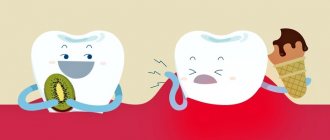Causes of candidal stomatitis
The most common cause of candidiasis stomatitis is a fungus of the Candida albicans group. It is worth noting that these fungi are always present on the mucous membranes of the mouth, and do not cause any harm to the body until they begin to multiply.
The causes of the development of candidal stomatitis are the following factors and diseases:
- Weak immunity;
- People with Sjögren's syndrome;
- Neglect of general rules of oral hygiene;
- Constant stress;
- Various diseases of the oral cavity;
- Taking antibiotics or corticosteroids;
- Having a disease such as diabetes. This is all due to the fact that the blood contains a large amount of sugar, and this serves as an excellent environment for the development of fungus of the genus Candida.
It is also worth noting that adults who suffer from excessive dry mouth can get candidal stomatitis. The most common cause of such dryness is the abuse of dental elixirs.
Another factor that can cause the development of candidal stomatitis is pregnancy. After all, it’s no secret that it is during this period that significant hormonal changes occur in a woman’s body, which, in turn, greatly affect the bacterial balance in the mouth.
Contraindications for use
Medical contraindications for taking Fluconazole capsules are pathological and physiological processes in the patient’s body, which include:
- Simultaneous use of the drug terfinadine, astemizole, as well as other drugs that lead to prolongation of the QT interval on the electrocardiogram (especially when using Fluconazole capsules in a daily dosage exceeding 400 mg).
- Children up to 4 years old.
- Individual intolerance to the main active ingredient or additional substances of this medication.
The drug is used with caution in case of concomitant liver or renal failure, the appearance of a skin rash in patients with generalized systemic fungal infections, simultaneous use of the drug in a daily dosage of less than 400 mg with terfenadine, chronic alcoholism, in the case of the use of drugs that have a hepatotoxic effect, and also in patients with a high risk of developing arrhythmia (disturbance in the rhythm and frequency of heart contractions) against the background of organic heart pathology, electrolyte imbalance in the body. The drug is also used with caution in pregnant women. Before prescribing Fluconazole capsules, the doctor makes sure that the patient has no contraindications.
Symptoms
A number of symptoms are characteristic of candidal stomatitis:
- The appearance of a white or yellowish coating on the tongue, cheeks or palate. When trying to eliminate it, bleeding wounds may appear on the mucous membrane.
- Constant metallic taste.
- Feeling of heartburn on the tongue.
- Painful sensations from touching plaque.
- Later, as plaque spreads, difficulty swallowing occurs.
- Deterioration of tongue sensitivity and poor taste perception.
Clinical researches
Repeated clinical studies have proven that the two-component mouth rinse ASEPTA ACTIVE more effectively combats the causes of inflammation and bleeding compared to single-component rinses - it reduces inflammation by 41% and reduces bleeding gums by 43%.
Sources:
- The role of anti-inflammatory rinse in the treatment of periodontal diseases (L.Yu. Orekhova, A.A. Leontyev, S.B. Ulitovsky) L.Yu. OREKHOVA, Doctor of Medical Sciences, Prof., Head of Department; A.A. LEONTIEV, dentist; S.B. ULITOVSKY, Doctor of Medical Sciences, Prof. Department of Therapeutic Dentistry of St. Petersburg State Medical University named after. acad. I. P. Pavlova
- The use of adhesive balm "Asepta®" in the treatment of inflammatory periodontal diseases L.Yu. OREKHOVA*, Dr. med. Sciences, Professor, Head of Department V.V. CHPP**, Dr. med. Sciences, Professor, Head of Department S.B. ULITOVSKY*, Dr. med. Sciences, Professor A.A. LEONTIEV*, dentist A.A. DOMORAD**, O.M. YAKOVLEV** SPbSMU named after. acad. I.P. Pavlova, St. Petersburg - *Department of Therapeutic Dentistry, **Department of Microbiology
- https://cyberleninka.ru/article/v/puti-sovershenstvovaniya-pervichnoy-profilaktiki-zabolevaniy-parodonta Acute herpetic stomatitis in children, Baranaeva E.A. Merkulova E.P. magazine "Medicine and Healthcare"
- https://cyberleninka.ru/article/v/osobennosti-protivoretsidivnogo-lecheniya-allergicheskogo-stomatita Acute stomatitis in children, Drobotko L.N., Strakhova S.Yu.
Forms of the disease
Candidal stomatitis is a fairly common disease that manifests itself in various forms. The symptoms can determine how much it is progressing. Treatment depends on the severity of the disease.
In the earliest stages, a mild form of the disease appears. It is characterized by the formation of single small white spots on the tongue or cheeks.
In the next middle stage, ulcers may form, and white spots themselves cover most of the tongue and mouth.
And at the most severe stages, plaque cannot be removed - it completely covers the entire oral cavity and forms a white film. Also, candidal stomatitis is classified separately depending on the location:
- Candidal stomatitis of the corners of the mouth. Very small cracks appear at the corners of the mouth, which cause pain. This is especially evident when opening the mouth.
- Yeast glossitis usually occurs on the surface of the tongue. It is characterized by a white coating and even swelling of the tongue.
- Thrush - the so-called yeast stomatitis - is a disease in which plaque forms on the cheeks and gums. The mucous membrane itself becomes reddened.
Side effects
Side effects are possible when using the drug Fluconazole
- From the immune system: hypersensitivity (cross with all azoles), other anaphylactic, anaphylactoid and allergic reactions (including Stevens-Johnson syndrome, toxic epidermal necrolysis, urticaria).
- From the nervous system: headache, dizziness, peripheral neuropathy, paresthesia, excessive fatigue, rarely - convulsions.
- From the digestive system: loss of appetite, dryness of the oral mucosa, changes in taste, abdominal pain, vomiting, nausea, diarrhea, flatulence, rarely - impaired liver function (jaundice, hepatitis, hepatonecrosis, hyperbilirubinemia, increased activity of alanine aminotransferase, aspartate aminotransferase, increased alkaline phosphatase activity, hepatocellular necrosis), including severe.
- From the hematopoietic organs: rarely - leukopenia, thrombocytopenia (bleeding, petechiae), neutropenia, agranulocytosis.
- From the cardiovascular system: increased duration of the QT interval, ventricular fibrillation/flutter, torsades de pointes.
- Metabolism: hypercholesterolemia, hypertriglyceridemia, hypokalemia, hyperglycemia.
- From the musculoskeletal system: myalgia.
- Other: weakness, asthenia, peripheral edema, neutropenia, itching, pulmonary edema, fever, excessive sweating, vertigo.
Treatment
First of all, when treating candidal stomatitis, you need to determine and eliminate the cause, adhere to the principles of proper nutrition and strengthen the body's immune system. And, of course, it is necessary to monitor oral hygiene. In most cases, this is quite enough for recovery.
If the disease is in a moderate or severe stage, the doctor often prescribes special medications for oral administration and antifungal ointments. Taking medications continues until the symptoms in the oral cavity are completely eliminated, in order to exclude possible relapses.
Treatment of mild forms of candidal stomatitis is carried out at home and does not require special conditions. Antifungal elixirs and lozenges are used. On average, the treatment course takes no more than two weeks.
More severe forms are characterized by the fact that the infection enters the digestive tract. Antifungal drugs are used to combat the disease. The course of treatment lasts from 2 to 4 weeks.
Recurrent forms of candidal stomatitis require much more time and money. Treatment is carried out until all symptoms disappear completely. Various antifungal agents are used.
Treatment of candidal stomatitis must be combined with a special diet. First of all, you should stop eating foods that are rich in starch and various confectionery products, minimize the consumption of cereals, baked goods, potatoes, etc.
When treating candidal stomatitis, other concomitant diseases should be eliminated, in particular:
- Caries;
- Periodontal disease;
- Chronic diseases of internal organs.
Pharmacodynamics
Antifungal agent. A triazole derivative exhibits an antifungal effect by blocking the biosynthesis of ergosterol in the cell membrane of fungi. The “target” for the action of the drug is the enzyme 14-α-demethylase.
14-α-demethylase is part of a group of enzymes known collectively as cytochrome P450. All enzymes of the cytochrome P450 group contain hematinic iron-containing pigment. Fluconazole binds to the iron atom of the hematin group and inactivates 14-α-demethylase, which leads to disruption of ergosterol synthesis and accumulation of lanosterol and other sterols. Their inclusion in the membrane instead of ergosterol significantly disrupts the structure and function of the fungal cell membrane.
A decrease in ergosterol synthesis, as well as the accumulation of 14α-methylsterols, destroys the tightly packed acyl chains of fungal membrane phospholipids. Destabilization of the fungal membrane leads to dysfunction of membrane enzymes, including those involved in the electron transport chain, and ultimately to cell death.
Used for systemic mycoses: candidiasis, cryptococcosis, blastomycosis, histoplasmosis, coccidioidomycosis, as well as dermatomycosis. The relatively low toxic profile and high penetration into the cerebrospinal fluid make fluconazole the drug of choice for systemic candidiasis and cryptococcal meningitis. Because of complications associated with intrathecal amphotericin B, fluconazole is the first-line drug for coccidioidal meningitis. Although fluconazole is active against the causative agents of blastomycosis, histoplasmosis, and sporotrichosis, it is inferior in effectiveness against the causative agents of these infections to itraconazole. Fluconazole is not effective against aspergillosis.
Prevention
To ensure that candidal stomatitis never bothers you, you should follow a few simple but very useful rules:
- Follow basic hygiene rules. Namely: wash your hands well with soap, especially when returning from the street, brush your teeth, use dental floss at least once a day, and also rinse your mouth with special means.
- You should definitely buy a new toothbrush. For those who have dentures, it is recommended to place them in a disinfectant solution overnight.
- After consuming liquid antibiotics, you should immediately rinse your mouth with water.
- When using spray corticosteroid drugs, you should wear a special nozzle.
Use during pregnancy and lactation
There have been no adequate and controlled studies of the use of fluconazole in pregnant women. Several cases of multiple congenital defects have been described in newborns whose mothers received high-dose fluconazole therapy (400-800 mg/day) for most or all of the first trimester. The following developmental disorders were noted: brachycephaly, impaired development of the facial part of the skull, impaired formation of the cranial vault, cleft palate, curvature of the femurs, thinning and elongation of the ribs, arthrogryposis and congenital heart defects. Currently, there is no evidence of a connection between the listed congenital anomalies and the use of low doses of fluconazole (150 mg once for the treatment of vulvovaginal candidiasis) in the first trimester of pregnancy.
During pregnancy, the use of fluconazole should be avoided, except in cases of severe and potentially life-threatening fungal infections when the expected benefit of treatment to the mother outweighs the possible risk to the fetus. Women of childbearing age should use contraception.
Since the concentration of fluconazole in breast milk and plasma is the same, the use of the drug during breastfeeding is contraindicated.











